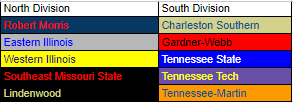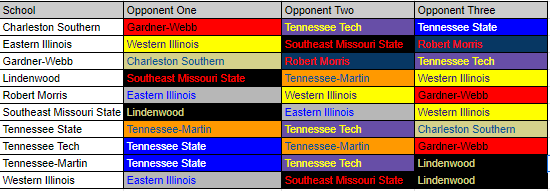•
Written By
Written By
•
•
•
Loading article...
Written By
Written By
The Big South-OVC's loss of Bryant not only tightens the alliance's footprint, but allows the league to organize itself better.
Written By
Omar-Rashon Borja
Senior Writer, Editor, Historian
Written By
Omar-Rashon Borja
Senior Writer, Editor, Historian

Conference expansion has just created a super league. Of course, I'm talking about the Coastal Athletic Association's addition of Bryant, which has turned the conference into a 16-team colossus on the gridiron. The marriage between Bryant and the Big South-Ohio Valley Conference alliance was short-lived, much like Kris Humphries and Kim Kardashian's relationship, ending after this season.
Normally, the uncertain age of conference realignment sparks panic when a school is lost. However, the Big South-OVC can breathe a sigh of relief. The conference's alliance becomes much more viable without the issue of constant travel from Smithfield, Rhode Island, to destinations such as Cape Girardeau, Missouri, or Charleston, Illinois.
While Robert Morris remains in the alliance, they don't pose as many problems as Bryant did. The Colonials are an average of 585 miles away from their Big South-OVC cohorts, with the farthest school, Southeast Missouri State, located 663 miles away. In comparison, Bryant was an average of 1068 miles away from their conference foes, with Southeast Missouri State being the farthest at 1217 miles. The loss of Bryant simply means gaining through subtraction.
Moreover, the Big South-OVC doesn't lose a playoff contender, as Bryant has never made the FCS Playoffs in its 15 years in the subdivision. Essentially, Bryant served as an insurance policy during an unsteady phase in realignment.
Looking back, Western Illinois' move from one Valley to another comes at a perfect time. The Leathernecks' move brings the Ohio Valley Conference's football-playing membership to seven members. The Big South membership of Robert Morris, Charleston Southern, and Gardner-Webb brings the alliance's total to ten members.
An even membership makes it easier to create pods or divisions within the league. Below is the table showing how north and south divisions could appear in the alliance.

Another option the league could consider is setting aside three permanent opponents for each school. The table below provides a rough projection of which matchups the alliance could preserve for each school. This format maintains in-state rivalries while optimizing travel as much as possible for every school.

Eleven schools might have made a division or pod structure difficult and awkward for the Big South-OVC. However, Bryant's departure, reducing the alliance to ten, tightens the Big South-OVC's geographic footprint and streamlines the scheduling format. Ultimately, Bryant's move to the CAA benefits both leagues involved and should solidify the Big South-OVC alliance.